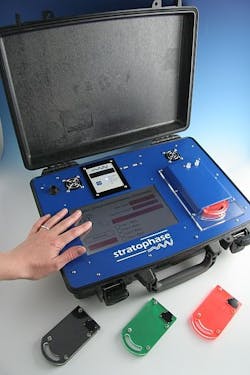Portable optical microchip performs accurate foot and mouth disease detection
Stratophase (Romsey, England) has wrapped up its Portable Direct Immunoassay Diagnosis Devices for Animals and Humans (PDIDDAH) project, which assessed the feasibility of using a self-contained, portable detection unit that uses proprietary optical microchip technology to accurately identify the presence of foot and mouth disease (FMD). The device couldâif further developedâallow veterinary professionals, inspectors and farmers to make rapid, informed decisions at the site of infection during disease outbreaks, avoiding the need to cull of healthy livestock.
Stratophase's transportable FMD detection unit, which uses the company's proprietary optical microchip technology, measures changes in refractive index (RI) at the surface of an optical chip. During analysis, the sample is mixed with a liquid and pumped across the chip surface, where any FMD viral particles present bind to specific receptor molecules, altering the local RI and leading to positive detection. The chips themselves are incorporated into low-cost, disposable cartridges, which are inserted into the detection unit during testing.
In addition to veterinary diagnostics, Stratophase's optical microchips can be configured to detect a whole range of biological agents, making them ideal for on-site testing in environments as diverse as battlefields, hospitals and farms, according to Richard Williams, Stratophaseâs CEO. The company expects to commercialize its portable detection solution for veterinary diagnostics in the future through collaboration with strategic partners already active in the field, he says.
The £1 million project, co-funded by the UK government-sponsored Technology Strategy Board (Swindon, England), was performed in collaboration with the Institute of Biotechnology (University of Cambridge; Cambridge, England), Bristol Industrial and Research Associates Limited (Bristol, England) and the Chelsea Technologies Group (Surrey, England).
-----
Posted by Lee Mather
Follow us on Twitter, 'like' us on Facebook, and join our group on LinkedIn
Follow OptoIQ on your iPhone; download the free app here.
Subscribe now to BioOptics World magazine; it's free!

